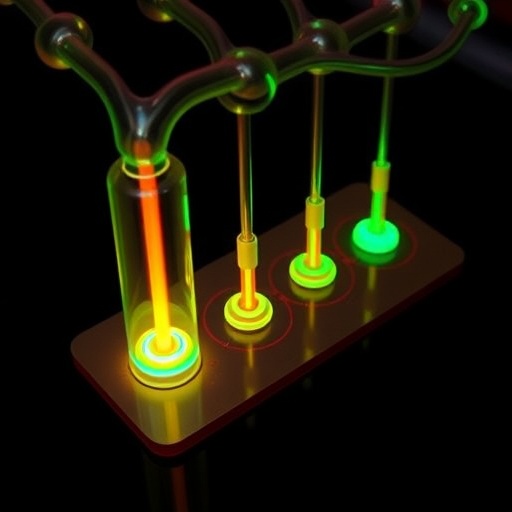In a groundbreaking study published in “Ionics,” researchers led by Zomorrodi, Marashi, and Sadeghian delve into an innovative approach to enhance the performance of lithium-ion batteries through a co-doping strategy. This research centers around the cathode material Li₂FeSiO₄, which has the potential to revolutionize energy storage technologies. The findings highlight the synergistic effects of incorporating tin (IV) and nitrogen-doped reduced graphene oxide (rGO) into the material, thereby enhancing its electrochemical properties significantly.
Lithium-ion batteries have become the backbone of modern energy storage solutions, powering everything from electric vehicles to portable electronics. However, the quest for materials that can improve battery efficiency, lifespan, and energy density is an ongoing challenge. The study identifies Li₂FeSiO₄ as a promising candidate but notes that its performance has historically been hampered by issues such as low conductivity and poor structural stability. This study aims to tackle these drawbacks using an innovative dual-doping strategy.
The researchers explored the use of tin (IV) as a dopant in the cathode material, which was found to facilitate the conduction of lithium ions. This property is crucial for efficient battery operation, as faster ion transport directly correlates with improved battery performance. By integrating tin (IV), the Li₂FeSiO₄ material benefits from enhanced electrochemical kinetics. This ensures that lithium ions can move more freely within the structure, contributing to higher capacity and faster charge-discharge cycles.
Additionally, the incorporation of nitrogen-doped rGO plays a significant role in improving the electronic conductivity of the cathode material. Graphene oxide, when reduced and doped with nitrogen, exhibits remarkable electrical properties, which can complement the deficiencies of traditional conductive additives. The synergistic effect of reduced graphene oxide is particularly noteworthy; its high surface area and electron-rich nature provide a robust conductive network, enhancing the overall conductivity of the Li₂FeSiO₄ matrix.
The authors meticulously conducted a series of experiments to characterize the structural and electrochemical properties of the dual-doped cathode material. Scanning electron microscopy (SEM) and transmission electron microscopy (TEM) analyses revealed a homogenous distribution of the dopants, confirming that they were effectively integrated into the Li₂FeSiO₄ structure. These images illustrated not just the morphology but also the interconnected porosity which is vital for lithium ion transport.
In parallel, the electrochemical performance was evaluated through galvanostatic charge-discharge tests, cyclic voltammetry, and electrochemical impedance spectroscopy. The results were promising. The dual-doped Li₂FeSiO₄ demonstrated a significantly higher specific capacity compared to the undoped version. The enhanced capacity retention over prolonged cycling indicated that the structural integrity of the material was maintained, reaffirming its suitability for long-term energy storage applications.
Furthermore, the researchers pinpointed the mechanisms that provided this enhanced performance. The nitrogen dopants in the rGO were found to create additional active sites for lithium-ion storage, while the tin (IV) dopants facilitated faster lithium-ion migration within the material. This dual mechanism underscores the importance of exploring multi-component doping strategies in material science.
This dual-doping approach marks a significant step forward in battery technology, suggesting that combining different dopants can lead to synergistic improvements that exceed what each dopant can achieve in isolation. It opens the door for further research into alternative doping elements and strategies that could be employed to tailor cathode materials for specific applications, offering significant insights into the engineering of next-generation battery systems.
In conclusion, the study clearly demonstrates that the synergistic enhancement of Li₂FeSiO₄ through a dual-doping strategy is a milestone in the development of efficient and robust lithium-ion battery materials. The potential implications are vast, spanning across various sectors including electric mobility and renewable energy storage systems. Future studies may focus on scaling up this process and investigating the long-term stability and environmental implications of using such materials.
As advancements in battery technology continue to evolve, the insights gained from this research underscore the importance of innovation in material design. By harnessing the power of dual doping with tin (IV) and nitrogen-doped rGO, researchers are paving the way for the next generation of batteries that are not only more efficient but also more sustainable.
The findings detail why ongoing research in materials engineering is crucial for addressing the challenges posed by modern energy demands and climate change. This study represents a significant contribution to the field and sets a precursor for future innovations in lithium-ion battery technology.
These advancements could help us achieve higher efficiency energy storage solutions, bridging the gap between current technological capabilities and future energy demands.
The commitment and creativity shown by Zomorrodi and colleagues in their comprehensive research illustrate the potential for future breakthroughs in battery technology. They reveal how interdisciplinary approaches combining materials science, chemistry, and electrical engineering can lead to groundbreaking developments.
Looking ahead, it’s clear that the exploration of dual-doping strategies will not only enhance the performance of Li₂FeSiO₄ but could also influence the optimization of other battery materials, driving us closer to sustainable energy solutions.
By strategically expanding our understanding of how to manipulate material properties at the atomic level, we can further enhance energy storage technologies that are crucial for the success of renewable energy systems globally.
As this research gains traction, it serves as a reminder of the relentless pursuit of innovation in the quest for more efficient energy solutions that are critical for the future of the planet.
Subject of Research: Co-doping strategy for enhancing Li₂FeSiO₄ cathode materials in lithium-ion batteries.
Article Title: Synergistic enhancement of Li₂FeSiO₄ cathode material via Sn(IV) and nitrogen-doped rGO co-doping strategy for lithium-ion batteries.
Article References:
Zomorrodi, S., Marashi, P., Sadeghian, Z. et al. Synergistic enhancement of Li 2 FeSiO 4 cathode material via Sn (IV) and nitrogen-doped rGO co-doping strategy for lithium-ion batteries. Ionics (2025). https://doi.org/10.1007/s11581-025-06544-2
Image Credits: AI Generated
DOI: https://doi.org/10.1007/s11581-025-06544-2
Keywords: Lithium-ion battery, dual-doping, Li₂FeSiO₄, tin (IV), nitrogen-doped rGO, electrochemical performance, energy storage solutions.




